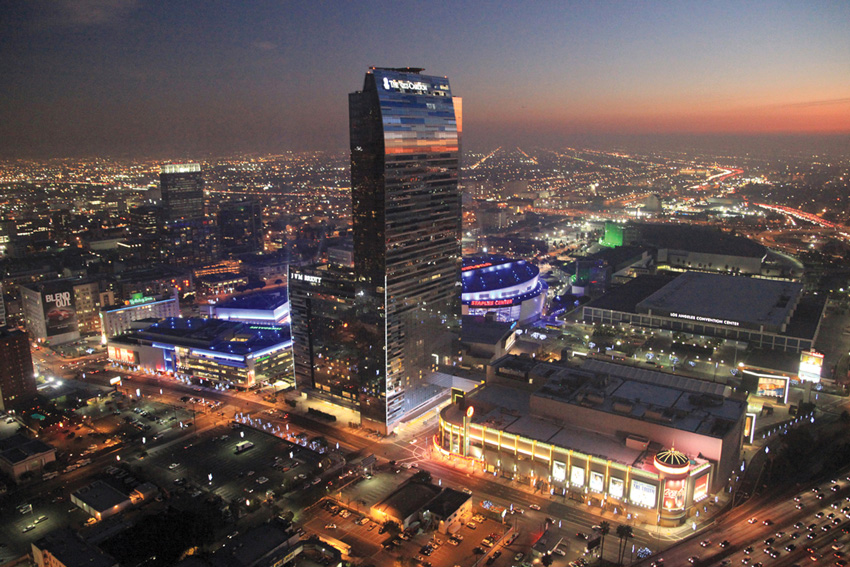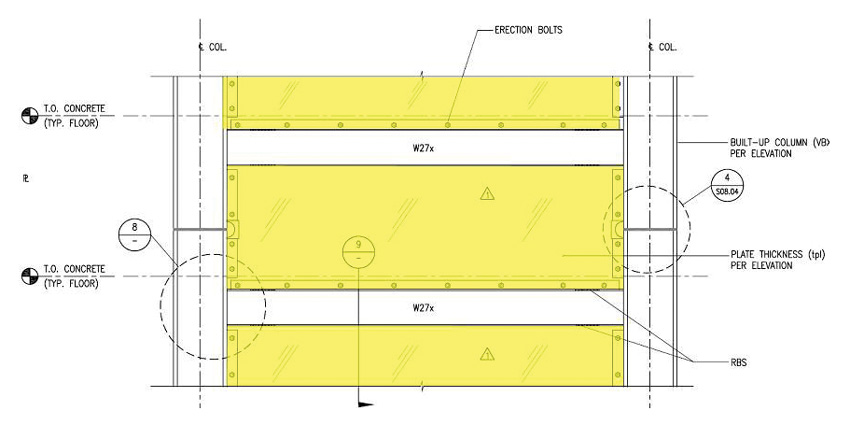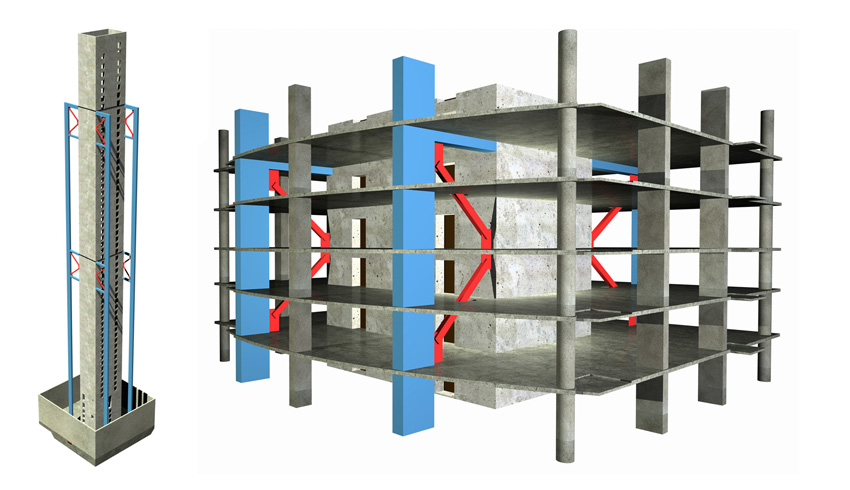The Core of the Matter
LA Live Project
Delivering more programming space than thick concrete walls were capable of doing, SPSW were selected for the core of the LA Live project in Los Angeles to resist lateral loads, add stiffness, support seismic needs, and decrease gravity loads. Combining hotel rooms and condos, the Gensler-designed dual towers stand 26 stories and 29 stories, respectively.

Photo courtesy of Nabih Youssef Associates
Offering more programming space than concrete, Nabih Youssef Associates specified steel plate shear walls to resist lateral loads, add stiffness, support seismic needs, and decrease gravity loads for the LA Live project in Los Angeles.
Specified by structural engineer Nabih Youssef Associates, unstiffened thin steel plates—ranging from 1/4-inch to 3/8-inch thick—inside fully welded unreinforced flange-welded (WUF-W) connected moment frames act as boundary members. As described in an AISC case study, the infill plates buckle in shear and form a diagonal tension field, which resists lateral loads and delivers a high level of post-buckling ductility.

Image courtesy of Nabih Youssef Associates
The unstiffened thin steel plates inside fully welded WUF-W moment frames are between 3/8-inch and 1/4-inch thick and act as boundary members for the LA tower. The infill plates buckle in shear and form a diagonal tension field, which acts to resist lateral loads and offers a high level of post-buckling ductility.
In absence of a centralized core of walls and due to the fact that the 26-story tower floor plan is designed as a “T” shape, the steel plates work to “tune” the stiffness of the separate wings.
Further limiting building drift, outriggers designed at mid-height and the roof level work to reduce the aspect ratio from 20:1 to 10:1. Buckling restrained braces (BRBs), some as large as 2,200 kips, are applied as fuse elements to control the maximum forces the outrigger trusses are capable of imposing upon the surrounding elements. Although this is no longer the case, at the time when the towers were designed, the BRBs bore the distinction of being the largest applied global system to be tested.
In addition, the 3/8-inch-thick steel plate shear walls add significantly more usable square footage than 3-foot-thick concrete core walls are capable of delivering.
Rigging Up with Outriggers
The taller a lateral system is, the harder it is to control lateral movement in a building, so outriggers are a good way to boost the stiffness and strength of the core.
“Outrigger systems can provide a lot of additional stiffness to a core by effectively mobilizing the perimeter columns, and hence the overall width of the building, to resist the overturning forces from the wind,” adds Jackson. “Due to this increase in width that they can mobilize, less steel is needed to provide the same stiffness.”Defined as braces connecting the outside of a building structure to the inside, outriggers work to keep a building’s aspect ratio to between 12:1 or 13:1, to prevent the building from moving too much.

Image courtesy of Magnusson Klemencic Associates
MKA’s engineering design for One Rincon Hill’s high-rise residential towers in San Francisco illustrates how the outrigger sits outside the core to lend added stiffness and support to the building structure.
Comparing an outrigger to the process of people losing their balance and reaching out to brace themselves, Cross explains that the outrigger leans on the gravity framing to help secure the building.
“The outrigger locks the core for added stability and resistance,” explains Sarkisian. “Typically designed at the mechanical level where it won’t impact usable square footage, the outrigger is a very efficient way to resist loads.” Outrigger-braced cores are a popular choice for taller buildings because they usually only impact every 10 to 15 stories of floors. With the exception of super-tall buildings with belt trusses, an outrigger-braced core system leaves the building perimeter as free of structure as possible, thereby maximizing unobstructed views, says Santi. “I would estimate that more than half of all outrigger systems around the world are constructed out of steel trusses, and the connections of steel outrigger trusses to a steel-framed core are far simpler and less time consuming than connecting steel outrigger trusses to a concrete core.”
By linking the core to the perimeter, outriggers enable the core to be engaged to the full dimension of the building. But to ensure optimal performance, Gottlieb stresses the importance of positioning the outriggers vertically and ensuring that the right number of outriggers are specified and installed.
While these systems can be very beneficial, the big issue is that a lot of lease space is negatively impacted by their presence. The design typically occupies two stories in height and connects the core to the perimeter columns. This is often combined with a perimeter “belt” truss that ties all the perimeter columns together, explains Jackson. The upshot is that constraints are placed on the floor layout, which is why the mechanical level is the best place to situate them. Because the most efficient location for an outrigger is typically about one-third of the way up the building, it is best to place the mechanical equipment at this location as well. However, for very tall towers, several levels of outriggers may be required, so outrigger placement may be a compromise between the optimum location for both structural and mechanical needs.
Santi also points out that outrigger systems are not inexpensive and can significantly slow down construction due to their uniqueness and complexity. This being the case, it’s important to conduct efficiency studies to minimize the size and number of outrigger levels.
“Another important factor when considering outrigger systems is the timing of connection of the outrigger to the core,” he adds. “The timing of connection must be managed properly, and often delayed until several more floors are constructed above the outrigger, to prevent unwanted gravity load transfer between the core and the perimeter columns through the outriggers.”
As an alternative to outriggers, a tube-in-tube system is a tube that runs around the perimeter of a building, essentially mobilizing the perimeter framing of the building to supplement the stiffness of the core. “A perimeter moment frame makes the building perimeter resist lateral loads, and can eliminate the need for outriggers or additional bracing that can compromise the space within the building,” explains Jackson.
Forming a square shape in elevation, it’s an efficient system that has been used in several prominent buildings. Such a perimeter tube system is in place at Chicago’s Sears Tower, a modified tube system frames 5 Times Square in Manhattan, and a perimeter lateral system with a gravity-only system for the tower core was designed for 7 Times Square.
“A tube system will generally require more expensive moment connections between the beams and columns, which can add to cost but may liberate more leasable space compared to an outrigger system,” explains Jackson.
The Arup engineer also points out that a tube system typically requires relatively closely spaced columns to work efficiently, so it should ideally be studied early in the design process so that it’s integrated into the overall design.
At the same time, Santi notes that this closely spaced column requirement, and subsequent obstructed views, is generally not a plus for owners and architects.









